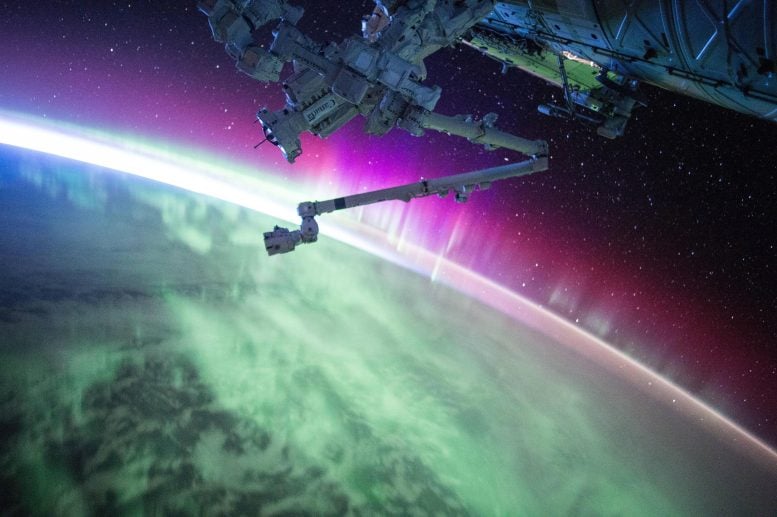
Scientists discover that interplanetary shocks that strike Earth’s magnetic field head-on cause more powerful ground-level electric currents, threatening pipelines and submarine cables.
Auroras are caused by particles from the sun hitting the Earth’s magnetic field — but these impacts also cause geomagnetically induced currents at ground level, which can damage infrastructure that conducts electricity. Scientists studying these currents to protect critical infrastructure have carried out the first research which compares interplanetary shocks to real-time measurements of geomagnetically induced currents, showing that the angle of the shocks’ impact is key for forecasting possible damage to infrastructure: shocks that hit the magnetic field at an angle produce less powerful currents.
The Impact of Interplanetary Shocks on Infrastructure
Auroras have inspired myths and portents for millennia — but only now, with modern technology dependent on electricity, are we appreciating their true power. The same forces that cause auroras also cause currents that can damage infrastructure which conducts electricity, like pipelines. Now scientists writing in Frontiers in Astronomy and Space Sciences have demonstrated that the impact angle of interplanetary shocks is key to the currents’ strength, offering an opportunity to forecast dangerous shocks and shield critical infrastructure.
“Auroras and geomagnetically induced currents are caused by similar space weather drivers,” explained Dr Denny Oliveira of NASA’s Goddard Space Flight Center, lead author of the article. “The aurora is a visual warning that indicates that electric currents in space can generate these geomagnetically induced currents on the ground.”
“The auroral region can greatly expand during severe geomagnetic storms,” he added. “Usually, its southernmost boundary is around latitudes of 70 degrees, but during extreme events it can go down to 40 degrees or even further, which certainly occurred during the May 2024 storm — the most severe storm in the past two decades.”
Lights, Color, Action
Auroras are caused by two processes: either particles ejected from the sun reach Earth’s magnetic field and cause a geomagnetic storm, or interplanetary shocks compress Earth’s magnetic field. These shocks also generate geomagnetically induced currents, which can damage infrastructure that conducts electricity. More powerful interplanetary shocks mean more powerful currents and auroras — but frequent, less powerful shocks could also do damage.
“Arguably, the most intense deleterious effects on power infrastructure occurred in March 1989 following a severe geomagnetic storm — the Hydro-Quebec system in Canada was shut down for nearly nine hours, leaving millions of people with no electricity,” said Oliveira. “But weaker, more frequent events such as interplanetary shocks can pose threats to ground conductors over time. Our work shows that considerable geoelectric currents occur quite frequently after shocks, and they deserve attention.”
Shocks that hit the Earth head-on, rather than at an angle, are thought to induce stronger geomagnetically induced currents, because they compress the magnetic field more. The scientists investigated how geomagnetically induced currents are affected by shocks at different angles and times of day.
To do this, they took a database of interplanetary shocks and cross-referenced it with readings of geomagnetically induced currents from a natural gas pipeline in Mäntsälä, Finland, which is generally in the auroral region during active times. To calculate the properties of these shocks, such as angle and speed, they used interplanetary magnetic field and solar wind data. The shocks were divided into three groups: highly inclined shocks, moderately inclined shocks, and nearly frontal shocks.
Angle of Attack
They found that more frontal shocks cause higher peaks in geomagnetically induced currents both immediately after the shock and during the following substorm. Particularly intense peaks took place around magnetic midnight, when the north pole would have been between the sun and Mäntsälä. Localized substorms at this time also cause striking auroral brightening.
“Moderate currents occur shortly after the perturbation impact when Mäntsälä is around dusk local time, whereas more intense currents occur around midnight local time,” said Oliveira.
Because the angles of these shocks can be predicted up to two hours before impact, this information could allow us to set in place protections for electricity grids and other vulnerable infrastructure before the strongest and most head-on shocks strike.
“One thing power infrastructure operators could do to safeguard their equipment is to manage a few specific electric circuits when a shock alert is issued,” suggested Oliveira. “This would prevent geomagnetically induced currents reducing the lifetime of the equipment.”
However, the scientists didn’t find strong correlations between the angle of a shock and the time it takes for it to hit and then induce a current. This may be because more recordings of currents at different latitudes are needed to investigate this aspect.
“Current data was collected only at a particular location, namely the Mäntsälä natural gas pipeline system,” cautioned Oliveira. “Although Mäntsälä is at a critical location, it does not provide a worldwide picture. In addition, the Mäntsälä data is missing several days in the period investigated, which forced us to discard many events in our shock database. It would be nice to have worldwide power companies make their data accessible to scientists for studies.”
Reference: “First direct observations of interplanetary shock impact angle effects on actual geomagnetically induced currents: The case of the Finnish natural gas pipeline system” by Denny M. Oliveira, Eftyhia Zesta and Sergio Vidal-Luengo, 7 May 2024, Frontiers in Astronomy and Space Sciences.
DOI: 10.3389/fspas.2024.1392697
1 Comment
A person can see the effects of UV on our communications network, simply watch broadcast television, before, during and after projected UV events.